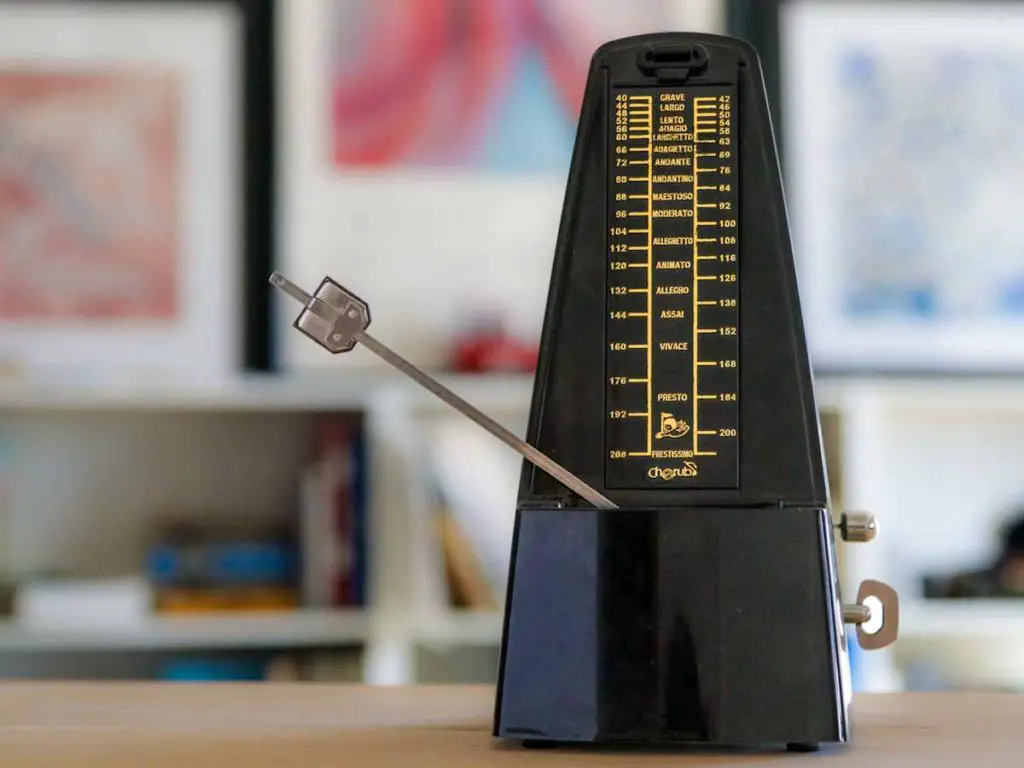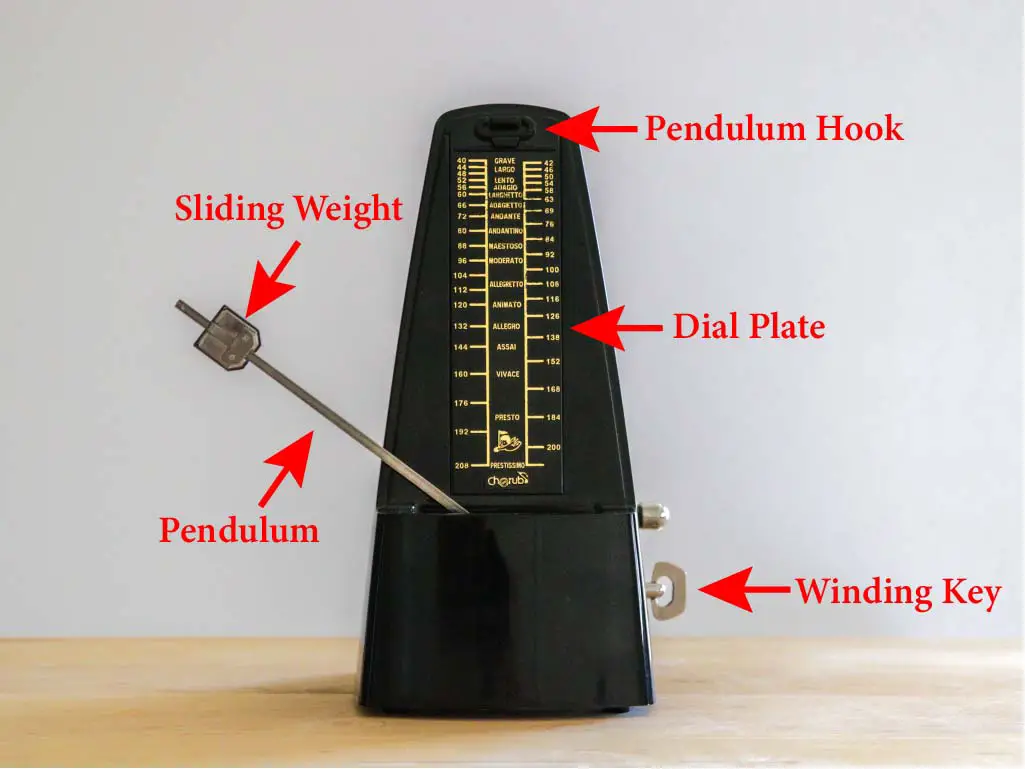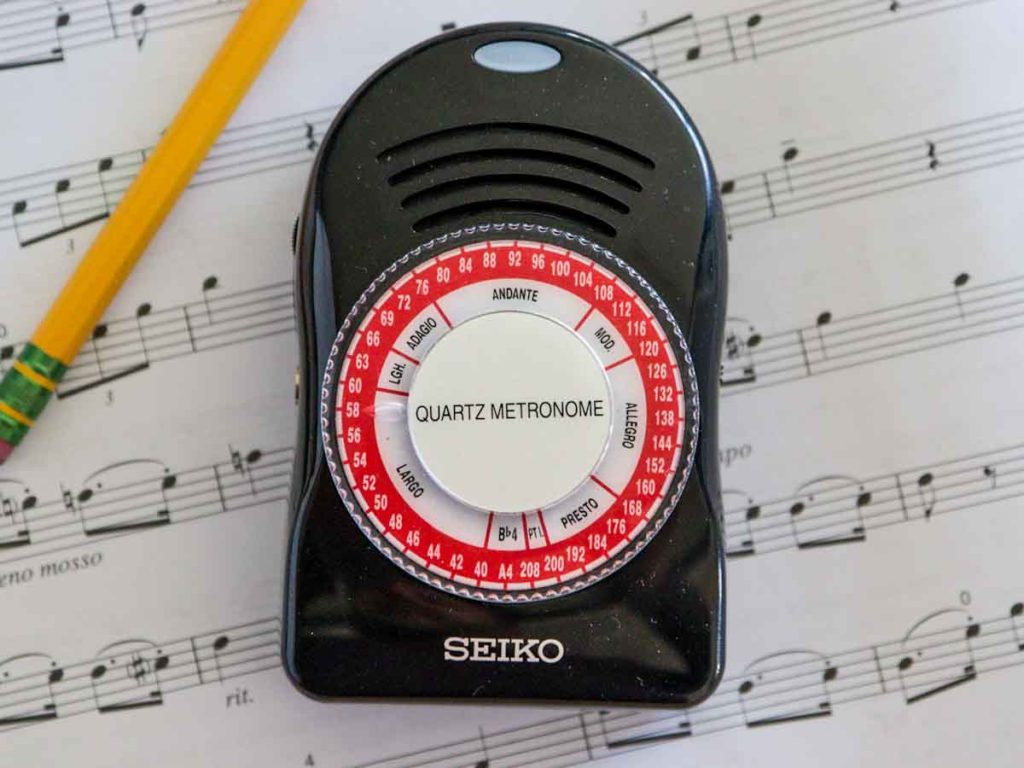
We may receive commissions from purchases made through links in this post, at no additional cost to you.
When your child is learning an instrument, at some point their teacher will say they need to have a metronome. If you’re reading this article, chances are you may not know exactly what a metronome is. And after a preliminary Google search, you probably have no idea which one to buy.
With options ranging from super old-timey-looking metronomes to fancy digital ones, it can be a bit intimidating knowing where to even start. Luckily, with a little explanation, you’ll be able to figure out exactly what a metronome is and which one will be best for your situation.
What is a Metronome?
A metronome is a device that creates an audible click at regular intervals to establish a steady beat for musical practice. The speed of the click, or tempo, is measured in beats per minute (BPM). Metronomes can be digital, mechanical, or app-based.
The word “metronome” has its roots in Latin. The first part, “métron,” means meter, and the second half, “nomós,” means tune or melody. Metronomes are used in musical practice for just about every instrument.
The metronome makes a clicking sound a certain number of times per minute (BPM). The speed of these clicks is also called the tempo. A metronome set to 60 BPM would beat exactly once per second (because there are 60 seconds in a minute). A metronome marking of 120 would be twice as fast.
This article is originally from www.dadstuffsite.com
Pro Tip: While it’s helpful to understand BPM when learning about a metronome, most musicians usually skip over actually saying “BPM” when referring to a tempo marking. We usually just say the number.
Frustrated trying to get your kids to practice? Check out Getting Your Child to Practice Music: 20 Tips for Motivation.
3 Kinds of Metronomes
There are three main kinds of metronomes: mechanical/analog metronomes (with a physical arm that moves side to side), digital metronomes, and metronome apps for a smartphone or tablet. Each is a perfectly acceptable option to use when practicing. Let’s look at each kind to decide which is the right option to buy for your child.
1. Mechanical/Analog Metronome
This might be the first thing you pictured when you thought of a metronome. This is the classic, chunky device that you probably saw on your grandmother’s piano.
To use a mechanical metronome, simply wind it up, adjust the weight on the pendulum to the corresponding BPM number on the dial plate, and release the pendulum from the pendulum hook. The pendulum should then rock back and forth at the set tempo.

The good thing about this kind of metronome is that you can see the beat clearly (with the swinging arm) and the click is clear and easy to hear. The tempo might be a little less accurate when the device needs to be rewound, but for the most part, it’s a good, consistent tool.
The major downside to a mechanical metronome is its bulk. If you want to have something that will look good on a piano or desk, then this is a great option (you can get really nice-looking ones). If you want something that can travel with your child to school (and chances are, if they’re going to do any sort of practicing at school, they should have one), they need something more portable.
I currently own a straightforward, black plastic one from Amazon that costs around $25. This one lives on our piano and we use it all the time. They come in lots of different colors and finishes, and if you want to spend a little more, you can get a nice one that’s made of wood.
This article is originally from www.dadstuffsite.com
Pros
- Looks nice
- Clear, loud click
- Clear visualization of the beat
- No batteries required
Cons
- Not portable
- Has to be wound up
- No options for subdivision
Related: 9 Reasons Your Child Should Practice with a Metronome.
2. Digital Metronome
When it comes to digital metronomes, they run the gamut from super cheap, to combination tuners, to top-of-the-line models. Unfortunately, that means there is a lot of sifting through metronomes that are either cheaply made, or overly complicated ones that you may decide to get someday but definitely don’t need now.
The problem I’ve had with many of the cheapest models is that over time they can get glitchy, and the sound usually isn’t loud enough to hear while practicing.
While it might show my age a little, I like the older-style digital metronome. These usually don’t have a digital screen and are adjusted using a large wheel. They tend to be a little thicker because they use a larger speaker, so they’re much easier to hear when practicing.
I like the Seiko SQ50-V Quartz Metronome, which I bought for my son when he needed a metronome. I had a metronome just like this when I was young, and it lasted me through college (and it only cost about $25).
You can also get super expensive digital metronomes. Boss makes an excellent metronome called Dr. Beat. But unless you feel like dishing out $150, you really don’t need one. If your child is a junior or senior high school percussionist looking to major in music in college, then you might consider it (percussionists can get a little OCD with the beat, which is why more percussionists have a Dr. Beat than other instrumentalists).
Most digital metronomes (including the two listed above) include a standard 3.5mm headphone jack. If your child is struggling to hear their metronome (or you’re sick of hearing it), they can just plug in a pair of headphones. The only potential issue is if you have wireless headphones or the newer style iPhone jack.
Pros:
- Relatively inexpensive
- Portable
- Has a 3.5mm headphone jack
Cons:
- Some aren’t loud enough
- Some are cheaply made
- Needs batteries
Related: Renting vs Buying a Beginner Instrument: Advice from a Pro
This article is originally from www.dadstuffsite.com
3. Metronome App
If you’re okay with your child having their own smartphone or tablet, then a metronome app is a great option. With the types of speakers on smartphones and tablets, there is no problem hearing the click when you practice. This is also great if you decide to use headphones as you can use whatever headphones you typically use with your smart device.
The really great thing about app metronomes is that they’re portable. If your child has their own smartphone then they’re probably never without it, so they don’t have to worry about remembering their metronome. Even better, there are some great free versions available.
The one I use (and I get no affiliate commission on this) is called “Pro Metronome.” The purchased version has some nice features, but the free version will be just fine for a beginner. I’m a professional musician, and the free version is plenty for me. If you decide to get the paid version, it’s still considerably cheaper than either of the other types of metronomes.
Related: Parent’s Survival Guide to the Flute: Basic Care, Terms, and How to Help


Pros:
- Super portable
- Cheapest option: free versions are available and paid versions are usually cheaper than most metronomes
- Uses high-quality speakers (as good as your phone/tablet)
- Compatible with smart device headphones
Cons:
- Can get distracted by the phone
- You must have a smartphone/tablet (if they don’t they’re borrowing yours)
Related Posts
Parent's Survival Guide to the Flute: Basic Care, Terms, and How to Help
A couple weeks ago your child decided they want to join band. You filled out the paperwork, signed up for the class, and their flute has finally come in. Your kid is super excited to start, but...
It’s a typical weekday morning and you are going through your child’s take-home folder. Along with the monthly lunch menu, you find a flyer about signing up for band or orchestra. That’s when...

